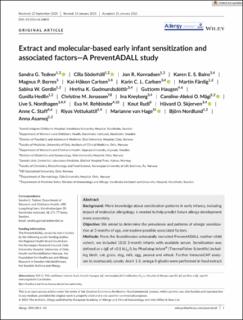Extract and molecular-based early infant sensitization and associated factors - A PreventADALL study
| dc.contributor.author | Tedner, Sandra G. | |
| dc.contributor.author | Söderhäll, Cilla | |
| dc.contributor.author | Konradsen, Jon R. | |
| dc.contributor.author | Bains, Karen Eline Stensby | |
| dc.contributor.author | Borres, Magnus P. | |
| dc.contributor.author | Carlsen, Kai-Håkon | |
| dc.contributor.author | Carlsen, Karin C. Lødrup | |
| dc.contributor.author | Färdig, Martin | |
| dc.contributor.author | Gerdin, Sabina W. | |
| dc.contributor.author | Gudmundsdóttir, Hrefna Katrín | |
| dc.contributor.author | Haugen, Guttorm | |
| dc.contributor.author | Hedlin, Gunilla | |
| dc.contributor.author | Jonassen, Christine M | |
| dc.contributor.author | Kreyberg, Ina | |
| dc.contributor.author | Mägi, Caroline-Aleksi O. | |
| dc.contributor.author | Nordhagen, Live Solveig | |
| dc.contributor.author | Rehbinder, Eva Maria | |
| dc.contributor.author | Rudi, Knut | |
| dc.contributor.author | Skjerven, Håvard Ove | |
| dc.contributor.author | Staff, Anne Cathrine | |
| dc.contributor.author | Vettukattil, Muhammad Riyas | |
| dc.contributor.author | van Hage, Marianne | |
| dc.contributor.author | Nordlund, Björn | |
| dc.contributor.author | Asarnoj, Anna | |
| dc.date.accessioned | 2021-07-06T07:52:35Z | |
| dc.date.available | 2021-07-06T07:52:35Z | |
| dc.date.created | 2021-06-29T11:04:18Z | |
| dc.date.issued | 2021 | |
| dc.identifier.citation | Allergy. European Journal of Allergy and Clinical Immunology. 2021, 1-10 | en_US |
| dc.identifier.issn | 0105-4538 | |
| dc.identifier.uri | https://hdl.handle.net/11250/2763486 | |
| dc.description.abstract | Background: More knowledge about sensitization patterns in early infancy, including impact of molecular allergology, is needed to help predict future allergy development more accurately. Objective: We aimed to determine the prevalence and patterns of allergic sensitization at 3 months of age, and explore possible associated factors. Methods: From the Scandinavian antenatally recruited PreventADALL mother–child cohort, we included 1110 3-month infants with available serum. Sensitization was defined as s-IgE of ≥0.1 kUA/L by Phadiatop Infant® (ThermoFisher Scientific) including birch, cat, grass, dog, milk, egg, peanut and wheat. Further ImmunoCAP analyses to ovomucoid, casein, Ara h 1-3, omega-5-gliadin were performed in food extract s-IgE-positive children. Maternal sensitization was defined as s-IgE ≥ 0.35 kUA/L to Phadiatop® (inhalant allergen mix) and/or Fx5 (food allergen mix) at 18-week pregnancy. Results: Overall 79 (7.3%) infants had specific sensitization, many with low s-IgE-levels (IQR 0.16–0.81 kUA/L), with 78 being sensitized to food extract allergens; 41 to egg, 27 to milk, 10 to peanut, and 25 to wheat. A total of 62/78 were further analysed, 18 (29%) had s-IgE to ovomucoid, casein, Ara h 1-3 and/or omega-5-gliadin. Eight infants (0.7%) were sensitized to inhalant allergens. Maternal sensitization to food allergens was associated with infant sensitization, odds ratio 3.64 (95% CI 1.53–8.68). Conclusion: Already at 3 months of age, 7% were sensitized to food, mostly without detectable s-IgE to food allergen molecules, and <1% to inhalant allergens. Maternal food sensitization was associated with infants’ sensitization. | en_US |
| dc.language.iso | eng | en_US |
| dc.publisher | Wiley | en_US |
| dc.subject | sensitization | en_US |
| dc.subject | molecular allergology | en_US |
| dc.subject | immunoglobulin E antibodies | en_US |
| dc.subject | IgE | en_US |
| dc.subject | birth cohort | en_US |
| dc.title | Extract and molecular-based early infant sensitization and associated factors - A PreventADALL study | en_US |
| dc.type | Peer reviewed | en_US |
| dc.type | Journal article | en_US |
| dc.description.version | publishedVersion | en_US |
| dc.rights.holder | Open Access | en_US |
| dc.source.pagenumber | 1-10 | en_US |
| dc.source.journal | Allergy. European Journal of Allergy and Clinical Immunology | en_US |
| dc.identifier.doi | https://doi.org/10.1111/all.14805 | |
| dc.identifier.cristin | 1919231 | |
| cristin.ispublished | true | |
| cristin.fulltext | original | |
| cristin.qualitycode | 1 |
Tilhørende fil(er)
Denne innførselen finnes i følgende samling(er)
-
Artikler / Articles [1172]
-
Publikasjoner fra CRIStin [1111]
